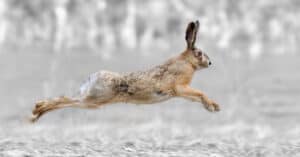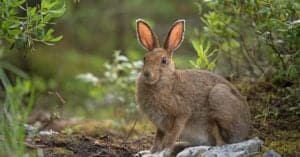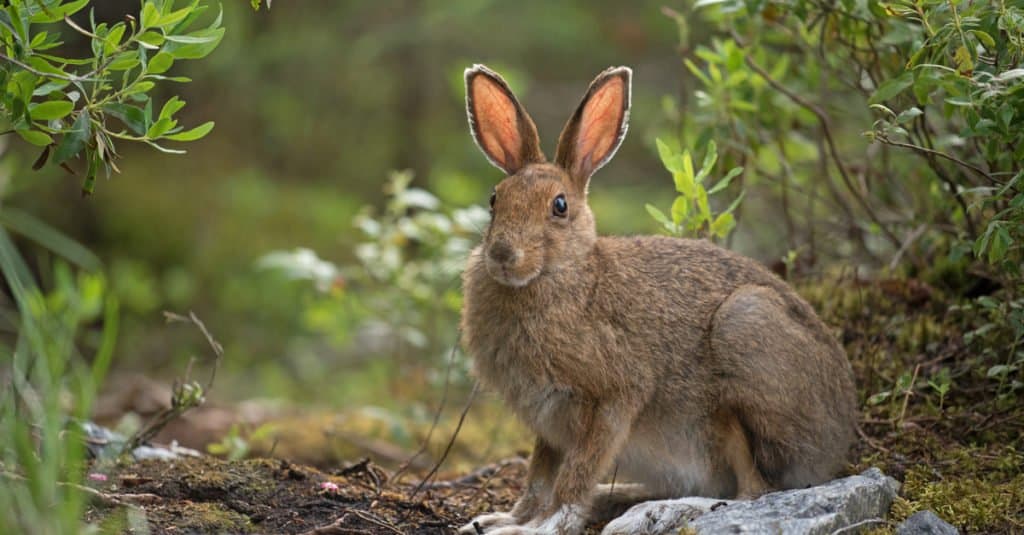
Snowshoe hares live in the boreal and coniferous woods of North America.
©RRichard29/Shutterstock.com
The Boreal and Coniferous woods of North America are home to the Snowshoe Hare (Lepus Americanus), a hare that lives in the forest. Its range reaches the upper altitudes of the Rocky, Appalachian, and Cascade Mountain ranges in the south, as well as the coastlines of the Arctic Ocean.
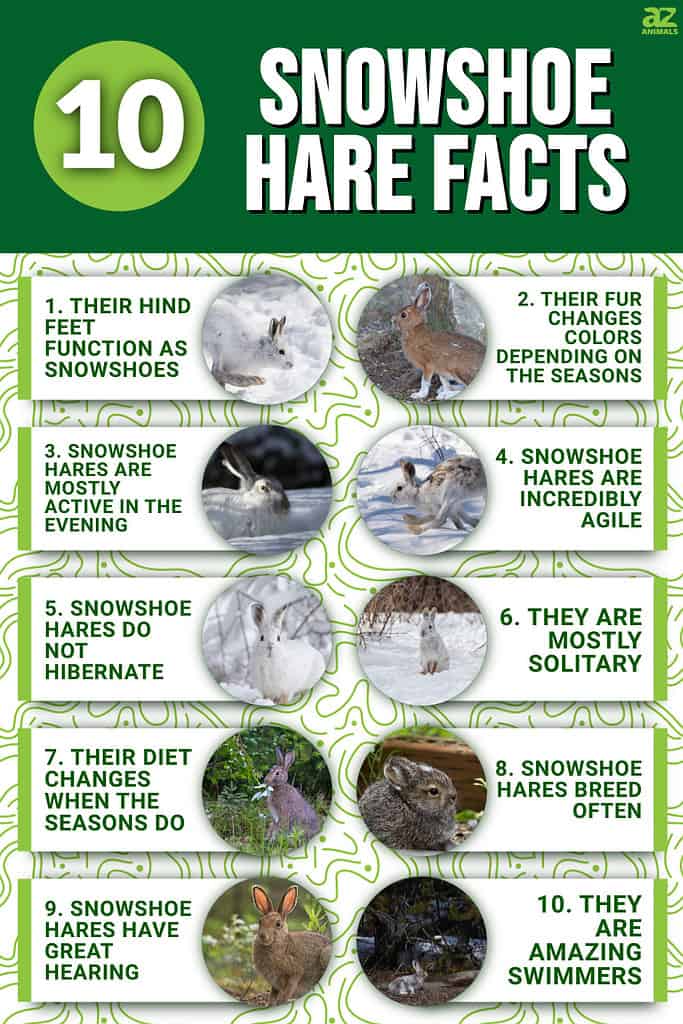
The genus Lepus includes animals like hares and jackrabbits. They belong to the same family as rabbits and hares, the Leporidae. Most species of rabbits and hares are smaller than snowshoe hares. Snowshoe hares differ from other hares by having longer rear legs, smaller ears, and big, furry feet. Continue reading below for 10 Amazing Snowshoe Hare Facts.
1. Their Hind Feet Function as Snowshoes (Hence the Name)
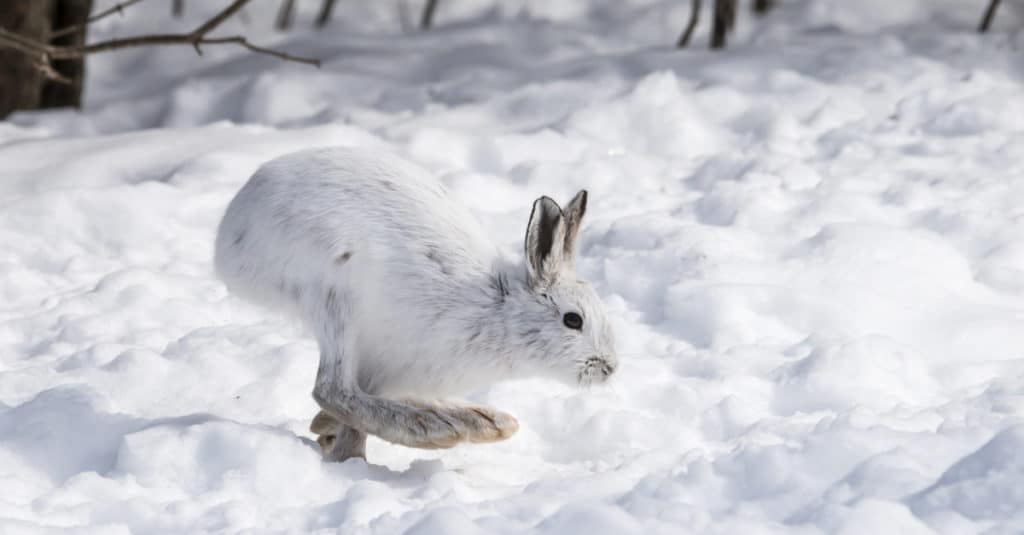
Snowshoe hares have huge feet that act like snowshoes.
©FotoRequest/Shutterstock.com
All four feet are huge in relation to body size, a snowshoe-like adaptation that allows the hare to move across snow. The hare’s hind feet are thickly furred to protect it from frigid temperatures. When closely examined, the snowshoe hare’s rear paws don’t even appear to be genuine. Even between their toe bones, they have some webbing.
2. Their Fur Changes Colors Depending on the Seasons

Snowshoe hares fur changes to brown in the spring.
Image: Jim Cumming, Shutterstock
©Jim Cumming/Shutterstock.com
In the spring and summer, the snowshoe hare’s fur is reddish brown, while in the winter it is white. Additionally, it always has a black tail and ear tips and a gray underside. Due to their snow-white fur, they are exceedingly difficult to notice in the winter if they stay still. They may benefit from this as a form of camouflage if surrounding predators are present.
3. Snowshoe Hares are Mostly Active in the Evening

Snowshoe hares are active during dawn, twilight, and at night.
Image: C_Gara, Shutterstock
©C_Gara/Shutterstock.com
Snowshoe hares are fascinating in a variety of ways, and like most creatures, they have different daily routines. However, because they are active in low light, they are most frequently spotted outside at dawn, twilight, and at night. They are active even on overcast days. Hares spend a lot of time grooming and napping intermittently during the day.
4. Snowshoe Hares are Incredibly Agile
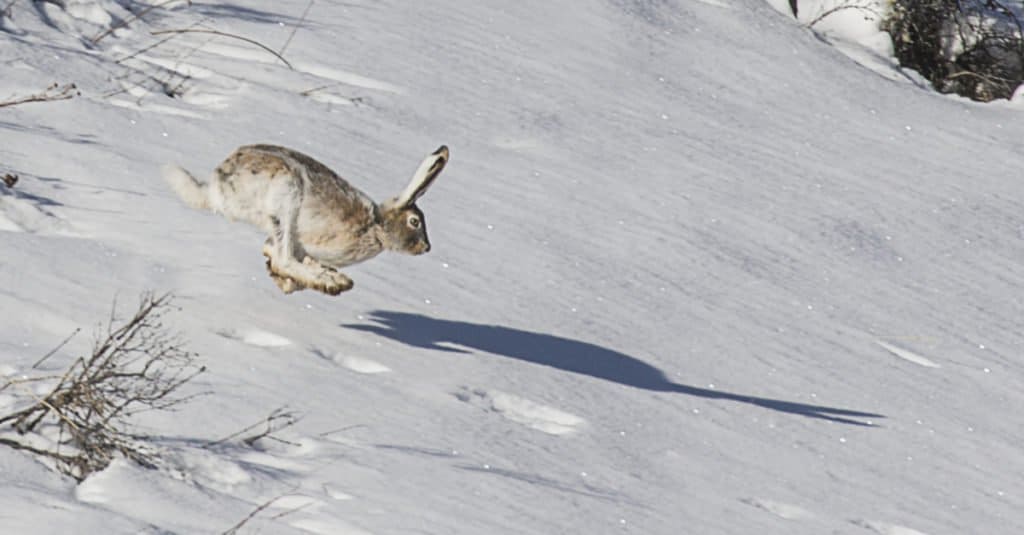
Snowshoe hares run at a top speed of 30 mph.
©Richard Seeley/Shutterstock.com
Snowshoe hares are swift and nimble, with a top speed of 25 to 30 miles per hour. To avoid predators, they can also change direction swiftly and jump up to 10 meters. The large rear legs of snowshoe hares allow them to move on top of the snow without sinking in.
5. Snowshoe Hares Do Not Hibernate

Snowshoe hares are active all winter.
Image: Jim Cumming, Shutterstock
©Jim Cumming/Shutterstock.com
The boreal, or northern forest is home to snowshoe hares. As a key prey species for a wide range of predators, hare abundance affects many predators’ population size and reproductive success. The boreal forests of North America are home to snowshoe hares, which are active all year long.
6. They are Mostly Solitary
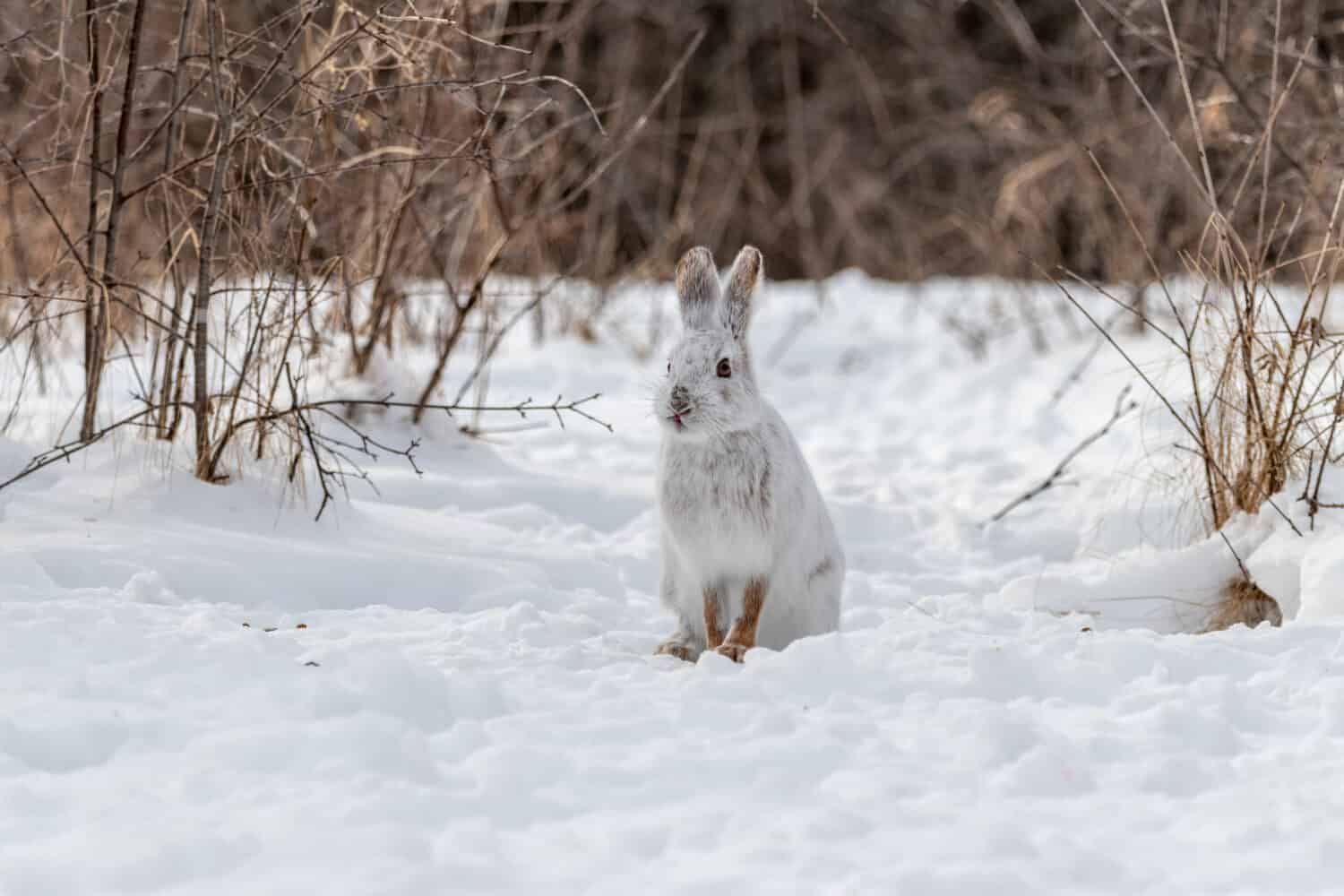
Snowshoe hares live mostly solitary lives.
Image: Karen Hogan, Shutterstock
©Karen Hogan/Shutterstock.com
Although snowshoe hares normally live alone, they frequently coexist in close quarters and have overlapping home areas. The young start eating grass at ten days old and are totally weaned from their mother’s milk at one month. They have grown to their full adult size by the time they are six months old and will breed the following spring. After that, they usually go their separate ways until breeding season.
7. Their Diet Changes When the Seasons Do
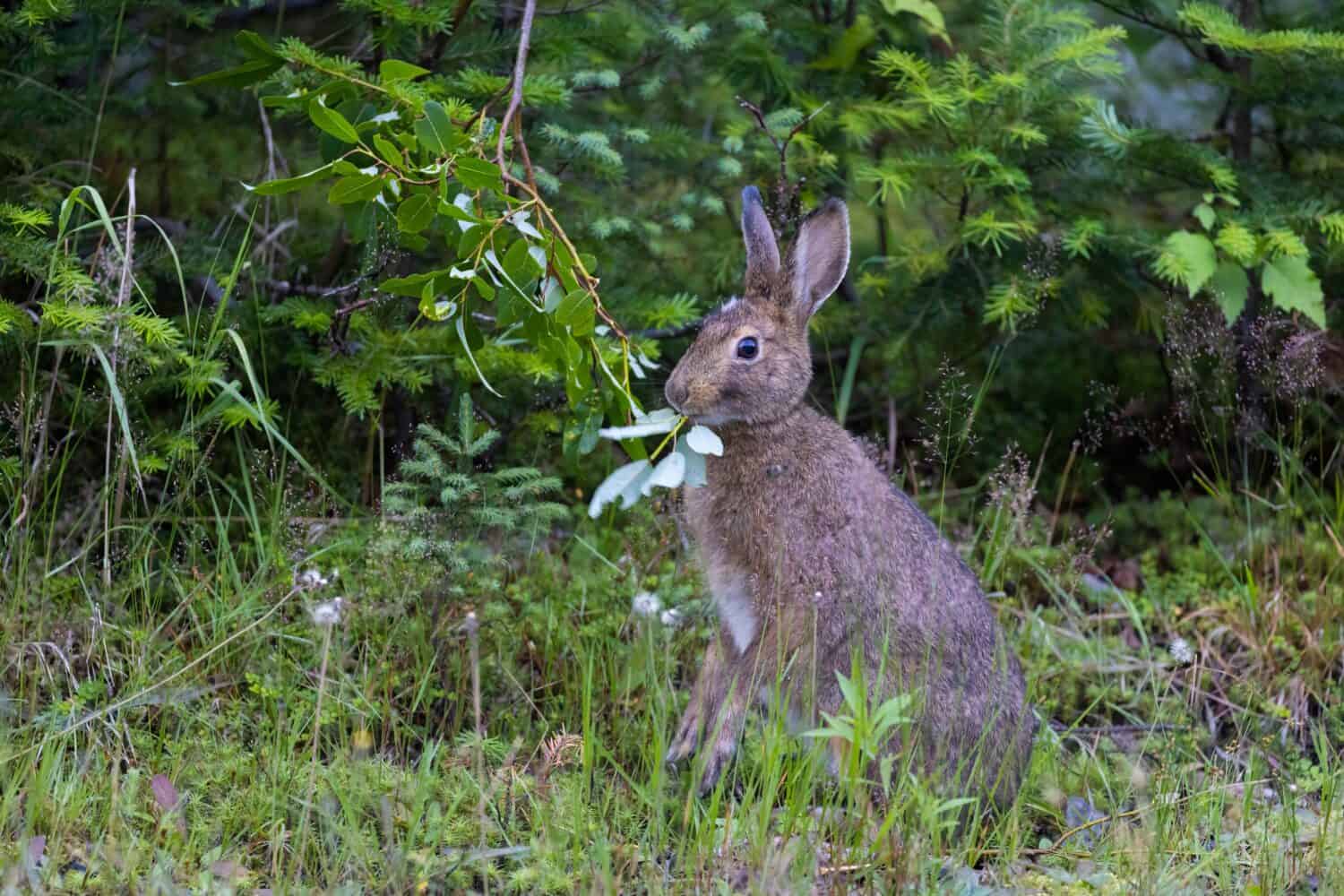
Grass, ferns, and leaves are favorite foods for snowshoe hares.
Image: Mircea Costina, Shutterstock
©Mircea Costina/Shutterstock.com
Their ability to adjust to whatever the season is shows how sophisticated their diet is. The snowshoe hare consumes grass, ferns, and leaves in the summer; in the winter, it consumes twigs, tree bark, and flower and plant buds. Like the Arctic hare, it has also been observed occasionally devouring dead animals.
8. Snowshoe Hares Breed Often

A baby snowshoe hare is called a leveret.
Image: Dee Carpenter Originals, Shutterstock
©Dee Carpenter Originals/Shutterstock.com
The first mating of the year takes place in the spring (March and April), and about 35 days after mating, a litter of typically two to four young (leverets) is born. Two to three litters of young are born to hares each year, and the females mate again soon after the birth of each litter. The average number of litters produced by snowshoe hares each year is 4, with 3 to 8 young.
9. Snowshoe Hares Have Great Hearing

Snowshoe hares have keen hearing.
©Tom Reichner/Shutterstock.com
Snowshoe hares have keen hearing and can recognize predators despite having smaller ears than most hare species. When they suspect something may be moving, they frequently lift their heads and perk their ears.
10. They are Amazing Swimmers

Snowshoe hares can swim if they have to.
Image: Hailey Giamarino, Shutterstock
©Hailey Giamarino/Shutterstock.com
Although they try to stay away from the water, snowshoe hares are excellent swimmers. Wildlife survival can be challenging. Snowshoe hares occasionally must swim over small lakes and rivers when they are defending themselves, that is when they are fleeing from a predator. They have been observed going into the water to escape becoming a meal.
The photo featured at the top of this post is © Jim Cumming/Shutterstock.com
Thank you for reading! Have some feedback for us? Contact the AZ Animals editorial team.




